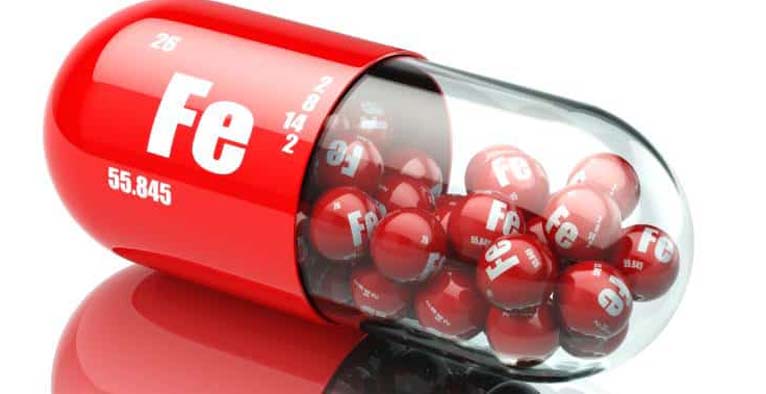How to increase the proportion of iron in the blood
Deficiency of iron in the blood
Iron is necessary for the production of blood proteins responsible for the transport of oxygen, known as hemoglobin. The lack of iron in the blood causes a defect in the function of these proteins, and thus lead to anemia. The body initially uses stored or recycled iron to form new blood cells. However, once stored iron is depleted, symptoms and signs begin to appear, such as fatigue, concentration disorders, headaches , skin pigmentation, nail weakness, and hair loss. The patient is usually subjected to blood tests after 12 hours of fasting; to determine the proportion of iron in the blood, and to diagnose and treat the symptoms manifest. The following are the most important tests that can determine the percentage of iron in the blood:
Blood serum level : Total Serum Iron The normal female rate is between 26-170 micrograms / dl and 76-189 μg / dl in males.
Saturation transferrin: (English: Transferrin Saturation) , which is responsible for carrying iron in the blood protein. Its normal range ranges between 204-360 mg / dL.
The total capacity of the iron link: (English: Total Iron Binding Capacity) or TIBC, which is a measure of the proportion of iron available to link Baltransvirin, and natural misfortune if the result is between 262-474 mcg / Dsaltr.
How to increase the proportion of iron in the blood
The consumption of the appropriate amount of iron by food is necessary for the health of the body; it is recommended to consume 7-18 mg of iron per day for most people, and 27 mg for pregnant women. It should be noted that the foods consumed affect the body's ability to absorb iron, in addition to its impact on the amount of iron consumed.
Iron supplements
Your doctor may recommend taking iron supplementation tablets that are available without prescription; to increase the proportion of iron in the blood. In general, the general health of the injured begins to improve within a week of intake of supplements, but the reduction in the proportion of iron in the blood may need months of treatment before returning to normal proportions. The patient is generally advised to take these tablets on an empty stomach, but may be taken with meals in the event of the cause of discomfort or discomfort in the stomach, and may be recommended to take some types of stool laxatives in the event of constipation as a side symptom of iron supplements.
Foods rich in iron
Iron in food is generally made up of two forms: Heme Iron and Non-heme Iron. The following are some of the most important foods containing iron forms:
Iron is the iron found in animal elements containing hemoglobin , and usually absorbs this iron better by the body; 40% is absorbed, and the most important sources:
Red meat
Chicken.
sea food.
Member meat as liver.
Non-Hemi Iron: This type of iron can be found in plant sources, iron-fortified foods, and many iron supplements. The following are some of the foods that contain this type of iron:
Green leafy vegetables: spinach and crunchy cabbage.
Dried fruits: such as raisins and apricots.
Cereals: Lentils and soybeans .
Foods that increase the absorption of iron
It is possible to increase the absorption of iron from food by introducing some types of foods rich in vitamin C in the diet, and eat with foods rich in iron, the following are some of the most important sources of vitamin C food:
Citrus and acidic juices.
Broccoli.
Pepper.
the strawberry.
tomatoes.
Melons.
Risk factors for iron deficiency
Some people may be more likely to have iron deficiency in the blood. Here are some factors that may increase the likelihood of iron deficiency:
Age: Children and infants are more likely to develop iron deficiency, due to the body's need for growth and development.
Lifestyle : Some lifestyle patterns may increase the risk of iron deficiency, such as dieting, frequent blood donation , and hard or stressful exercise.
Sex: Females are more likely to have iron deficiency; due to menstrual cycle, pregnancy, childbirth, and lactation.
Complications of iron deficiency in the blood
Iron deficiency is not usually caused by serious complications, but if not treated, the severity of iron deficiency may increase, resulting in health complications affecting the patient's life. Some of these complications are listed below:
Fatigue: Anemia caused by iron deficiency causes extreme fatigue and loss of energy (Lethargy), resulting in loss of ability to work, exercise, and even wake up sometimes.
Increased risk of infection: According to studies, the lack of iron in the blood affects the immune system of the body , and thus its ability to fight infection.
HEART DISEASE: An iron deficiency anemia causes heart arrhythmia or an increase in heart rate as a result of the heart's attempt to compensate for hypoxia , which may cause heart failure or malfunction of the heart muscle.
Pregnancy Disorders: Iron deficiency can lead to complications in pregnant women: early delivery, low birth weight, and postnatal depression .
Restless Legs Syndrome: (English: Restless Leg Syndrome) , a common condition that affects the nervous system and lead to the feeling of an urgent need to move the legs, in addition to the feeling of discomfort and discomfort in the feet and legs. Fibromyalgia syndrome caused by iron deficiency is usually treated with dietary iron supplementation.
Growth Disorders: The lack of high iron content in children leads to anemia , as well as delayed growth and development.










No comments:
Post a Comment